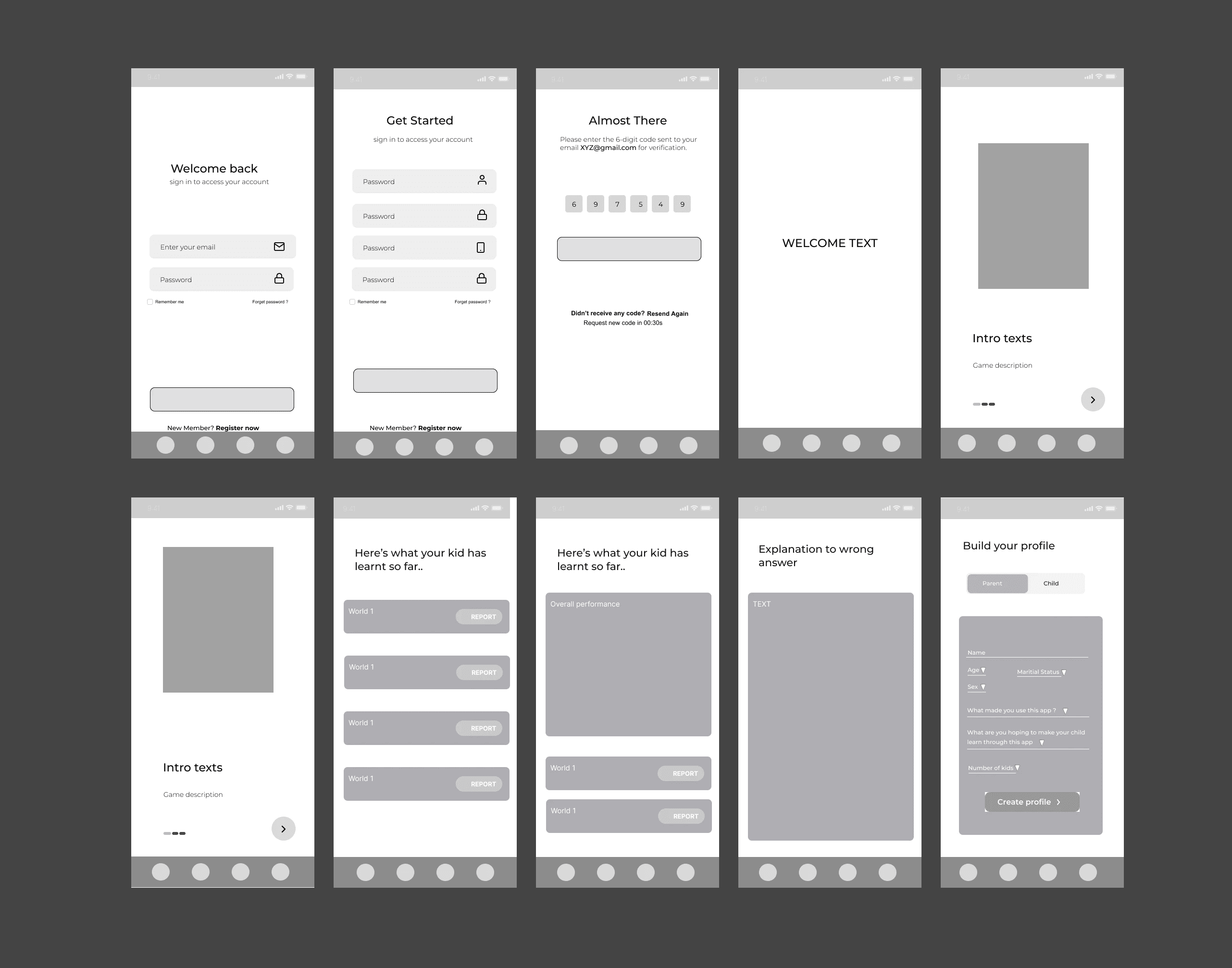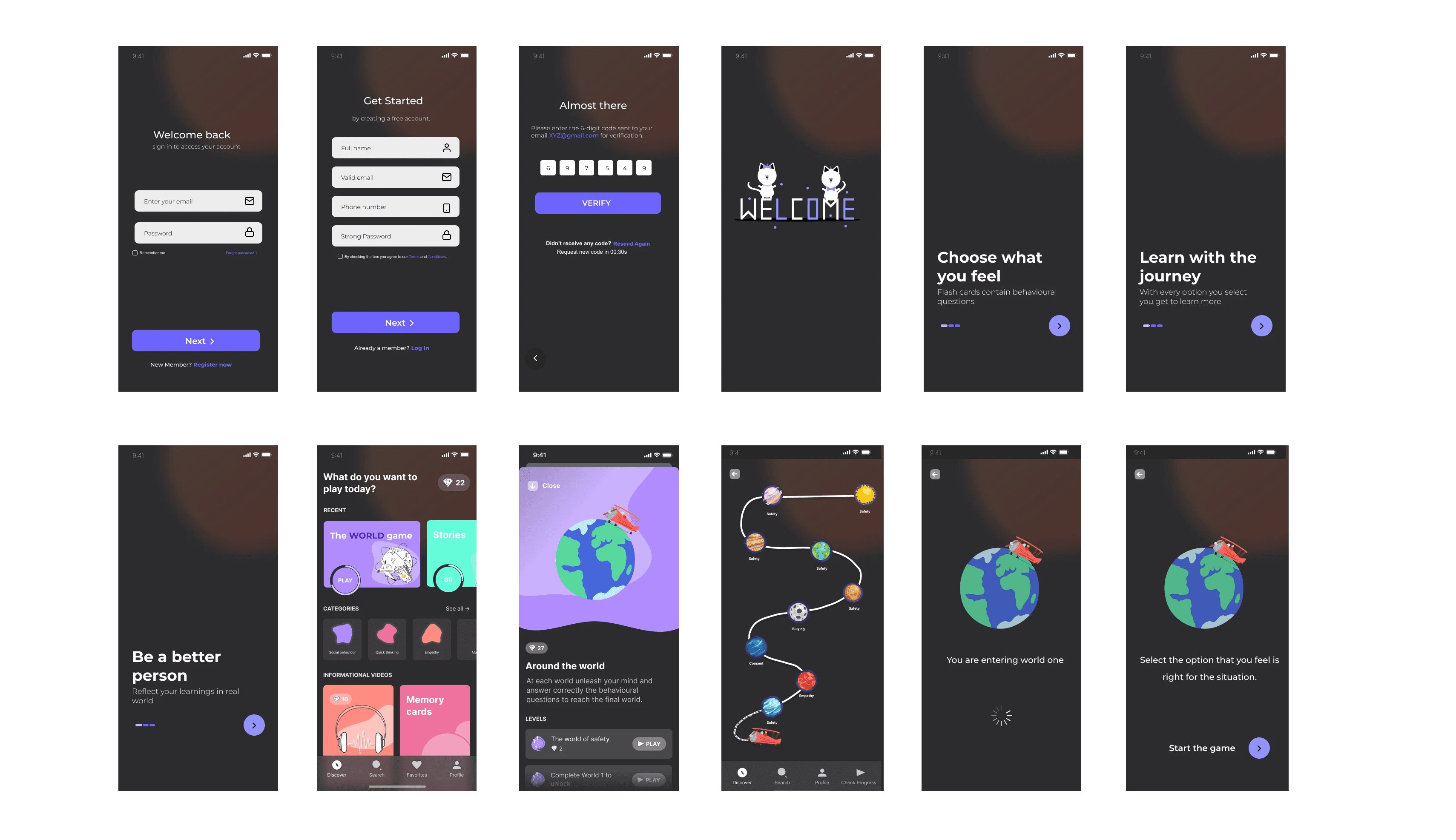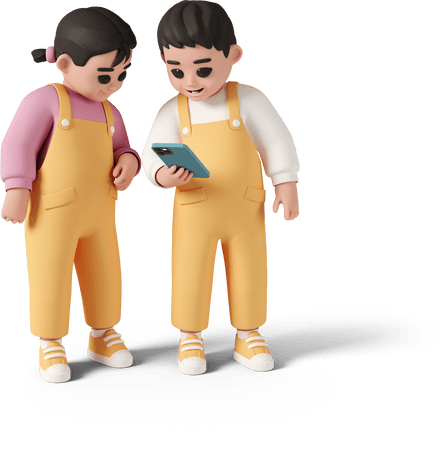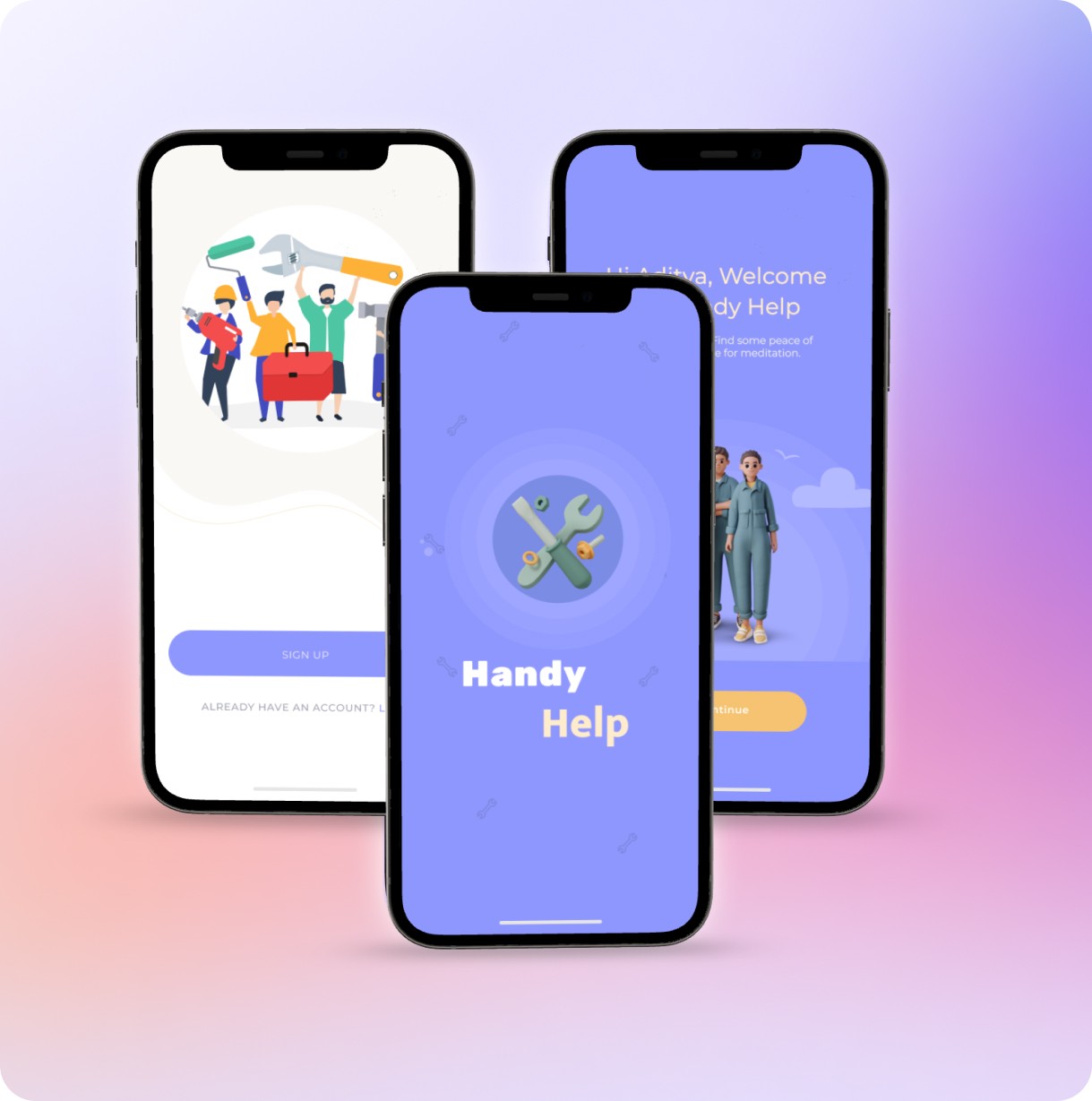Life Adventures
Vision
Challenges / problem statement.
Research / Analysis
Design Problem
Solution
Tasks
Task Environment
Analysis
Educational support
Safety assurance
Character development
Requirements
User Scenario
Ideation of designs..
"Life Adventures" is an innovative and engaging educational game designed to instill critical life values in children aged 6 to 12 through interactive flashcards and gamification. It focuses on teaching values such as consent, distinguishing between good and bad touch, empathy, handling emergencies, and addressing bullying.
Creating a game that was both educational and engaging for kids, while also addressing parents' safety concerns, posed the main challenge. The team aimed to find the right balance between learning and play.
To understand the needs and perspectives of the target audience, interviews were conducted with three Indian parents. Each interview, lasting around 28 minutes, shed light on the diverse needs and expectations of parents from different walks of life - a single working mom, a mother of two, and a working dad.
Parents emphasized the importance of a learning tool that was not only educational but also fun and impactful. They expressed a deep concern for their children's safety and the need for a tool that teaches kindness and empathy effectively.
"Life Adventures" is designed around a series of tasks that support its core mission of imparting vital life skills and values to children. These tasks are thoughtfully integrated into the gameplay to ensure that learning is both effective and engaging for its young audience.
At Home: "Life Adventures" transforms the home environment into a learning hub, fostering family bonding over shared values.
In Schools: As a classroom supplement, the game enriches the educational experience, making character education an integral part of the school curriculum.
Extracurricular Activity: Beyond academics, it provides a fun and engaging way for children to explore and learn essential life skills.
Online and Offline: Accessibility is key, with "Life Adventures" designed to be just as impactful whether played online or offline, ensuring no child is left behind.
Cultural Considerations: The game embraces diversity, offering content that respects and reflects the rich tapestry of cultures among its users.
Breakdowns
The journey of creating "Life Adventures" revealed occasional challenges, such as engaging diverse age groups and ensuring the content was universally relatable. These breakdowns highlighted the delicate balance needed between educational depth and playful engagement.
Needs for Better Tools
Feedback underscored the necessity for more intuitive interfaces and interactive elements to captivate the young audience. There's a clear demand for tools that can seamlessly blend learning with entertainment, making the educational experience as engaging as playing their favorite video games.
Current Systems
The analysis of current educational games showed a gap in addressing complex life skills and values comprehensively. Many existing systems focus on academic skills, leaving a void in character education and real-life scenario training.
Strengths and Weaknesses
"Life Adventures" shines with its strong focus on character education through interactive storytelling and decision-making scenarios. However, the challenge remains to continuously evolve the game's content and technology to keep pace with children's ever-changing interests and the latest educational strategies.
Differentiation
What sets "Life Adventures" apart is its commitment to tackling sensitive topics like consent, empathy, and bullying in an age-appropriate manner. Unlike other educational tools, it doesn't shy away from difficult conversations, making it a pioneering platform in character education. This differentiation is not just about what children learn but how they learn it—transforming passive screen time into an interactive learning adventure.
Step 1: Logging into the platform
Step 2: Choosing an appropriate learning module
Step 3: Engaging with interactive content:
Step 4: Reflecting upon learned values in real-world scenarios
Step 1: Accessing the safety module:
Step 2: Exploring safety scenarios:
Step 3: Learning and practicing safety skills:
Step 4: Parental involvement:
Step 1: Choosing a character development journey
Step 2: Exploring character-building activities
Step 3: Real-world application
Step 4: Monitoring progress:
At the heart of their concerns, parents prioritize the safety, mental health, and moral development of their children above all else. They understand the importance of nurturing a strong set of values from a young age, recognizing that these elements are crucial for their children's well-being and future success. "Life Adventures" is crafted with this fundamental understanding in mind, serving as a bridge to address these vital needs. It offers an engaging and meaningful platform for character education, meticulously designed to resonate with both the aspirations of parents and the inquisitive minds of children. Through its captivating gameplay and interactive lessons, "Life Adventures" not only enriches the learning experience but also fosters a safe environment for children to develop the essential values and skills needed for navigating life's challenges.
Purpose-built for children aged 6 to 12.
Focuses on character education and values.
Engaging gamified experience.
Interactive flashcards for real-life scenarios.
Children make choices to develop decision-making skills.
Immediate feedback guides learning.
Customizable profiles for children.
Designed to empower parents in character development.
User-friendly and visually appealing interface.
Future enhancements include multimedia elements and rewards.
"How might we design an engaging and interactive educational game that effectively teaches children aged 6 to 12 critical life values such as empathy, consent, safety, and handling bullying, while also encouraging independent decision-making and providing support for parents in character development?"
Functional Requirements
User Registration: A simple, secure process allowing children and parents to create accounts, ensuring a personalized and protected learning environment.
Avatar Creation: Enables children to design their own avatars, fostering a sense of identity and personalization within the game.
Scenario Categories: A diverse range of categories that cover various life skills and values, making it easy for users to navigate through different learning modules.
Flashcard Scenarios: Interactive flashcards present real-life situations, challenging children to think critically about how they would respond.
Decision-Making Interactivity: This feature engages children in making choices during scenarios, actively involving them in the learning process.
Immediate Feedback: After each decision, the game provides feedback, offering praise or suggestions for improvement, which aids in reinforcing learning.
Parental Monitoring: A dashboard for parents to track their child's progress, understand their learning journey, and identify areas for further discussion.
Parent-Child Discussion: The game encourages conversations between parents and children about the scenarios faced, enhancing the learning experience with real-world discussions.
Non-Functional Requirements
Engagement: The game must captivate the children's attention through compelling content and interactive elements, ensuring they remain interested and motivated to learn.
User-Friendly: An intuitive interface that is easy for children to navigate, ensuring a frustration-free experience for users of all ages.
Offline Accessibility: The ability to access certain features of the game without an internet connection, making it available anytime and anywhere, ensuring learning is not hindered by connectivity issues.
Privacy: Strong privacy controls and data protection measures to safeguard personal information, ensuring a safe environment for children to play and learn.
Aarush, a 9-year-old, eagerly starts "Life Adventures," creating his unique avatar, 'Explorer Aarush,' to reflect his personal style.
He chooses to explore the 'Personal Boundaries' world, where he encounters educational flashcards about recognizing and responding to inappropriate touch.
The app offers immediate feedback on Aarush's choices, congratulating correct decisions and guiding him through incorrect ones.
If Aarush makes a wrong choice, his mom Ankita gets notified on the parent's dashboard, prompting her to discuss personal boundaries with him, reinforcing his learning.

Design Requirements


Personalized Avatars:




Distinct Worlds




Immediate Feedback




Parental Involvement



Life Adventures
An interactive child game for learning

High Fidelity prototypes
What do users think about this?
"The app looks promising for teaching values."
"I like that it focuses on values; it's important."
"It seems okay, but I expected more interactivity."




Feedback/suggestions..
Reflection
Future improvement
Increase Interactivity: Enhance the game's interactivity to keep children more engaged. This could involve more complex decision-making scenarios, interactive puzzles related to the learning objectives, or more direct interaction with the game's characters and environments.
Incorporate Fun Sounds and Music: Add background music and sound effects to make the game more immersive and appealing. Music can be themed to match different scenarios or worlds within the game, while sound effects can provide auditory feedback on the player's actions, enhancing the overall experience.
Utilize Sound for Engagement: Use sound strategically to grab attention and convey emotions, reinforcing the learning points. For instance, a cheerful tune when a correct decision is made or a gentle notification sound for incorrect choices, guiding the child towards reflecting and learning.
Implement a Reward System: Introduce a reward system to motivate children and acknowledge their progress. Rewards can be in the form of digital badges, points to unlock new levels or characters, or certificates that children can share with their parents. This system can also encourage children to revisit and master different scenarios, reinforcing their learning.
Reflecting on "Life Adventures," the toughest challenge was balancing educational content with engaging gameplay. If I could do things differently, I'd involve a wider range of users early on for feedback, to better tailor the game's design and interactivity. Additionally, I learned the importance of supporting diverse learning needs, recognizing that future enhancements should focus on inclusivity and accessibility to ensure every child can benefit from the game.
For future implementations of "Life Adventures," our roadmap is anchored in continuous improvement and the integration of new features to create a more engaging and educational environment. Here's our strategy:
Commit to Continuous Improvement: We plan to embed a culture of ongoing enhancement, integrating user feedback directly into the development process. By adopting an iterative design approach, we aim to continuously refine and evolve the application, ensuring it meets the evolving needs of its users.
Develop Complete Prototype: Our immediate next step is to develop a complete prototype, including all planned screens and functionalities. This will bring us closer to launching a fully functional application that delivers a comprehensive learning experience.
Integrate New Features: We are committed to regular updates and the integration of new features. By staying abreast of technological advancements and pedagogical strategies, we aim to keep "Life Adventures" at the forefront of educational gaming.
Create an Engaging Environment: We envision a game environment that captivates and educates simultaneously. To achieve this:
Confetti Animations: Celebrate correct answers with confetti animations, making learning milestones exciting.
Dynamic Music: Implement dynamic music that adapts to the learning scenario, enhancing the immersive experience.
Animated Visuals for Flashcards: Introduce animated visuals for flashcards, making each learning moment visually stimulating and memorable.
Thank you
Thankyou :) Also, Remember to stay hydrated 🍉
Designed by Aditya :)

Handy Help
#UIDesign #VisualDesign #ProductDesign #Highfidelity #Wireframing
Virtual Expertise for Every Home Maintenance Challenge

A user-friendly platform designed to help students find clubs, events, and friends with similar hobbies at Iowa State University
Cy Hobby
#UIDesign #VisualDesign #ProductDesign #Highfidelity #Wireframing